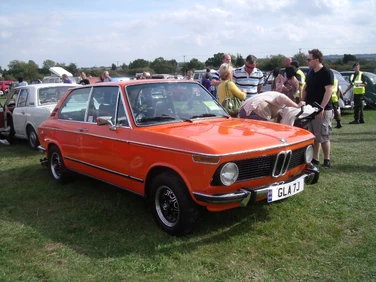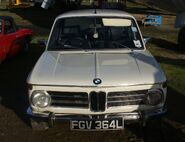
BMW 2002
The BMW New Class (German: Neue Klasse) was a line of compact sedans and coupes produced by German automaker BMW starting with the 1962 1500 and continuing through the last 2002s in 1977.
Powered by BMW's celebrated four-cylinder M10 engine, the New Class models featured a fully independent suspension, MacPherson struts in front, and front disc brakes. Initially a family of four-door sedans and two-door coupes, the New Class line was broadened to two-door sports sedans with the addition of the 02 Series 1600 and 2002 in 1966.
Sharing little in common with the rest of the line beyond the power train, the sporty siblings caught auto enthusiasts' attention and established BMW as an international brand. Precursors to the famed BMW 3 Series, the two-doors' success cemented the firm's future as an upper tier performance car maker.
New Class four-doors with numbers ending in "0" were replaced by the larger BMW 5 Series in 1972. The upscale 2000C and 2000CS coupes were replaced by the six-cylinder BMW E9, introduced in 1969 with the 2800CS. The 1600 two-door was discontinued in 1975, the 2002 replaced by the 320i in 1975.
1500 (4-doors)[]
Introduced in September 1961 at the Frankfurt Motor Show, the 1500 was produced from 1962 through 1966.
The four-door monocoque three-box four-door saloon, though modern to the eye, was in many ways conventional, using MacPherson strut front suspension which by this time was becoming mainstream. Less conventional was the independent rear suspension featuring coil springs and semi-trailing wishbones pivoted from a stout cross beam which also supported the differential housing. The "oversquare" cylinder dimensions of the original 1,499 cc model, along with the overhead camshaft marked out the car's new four-cylinder engine as a modern design, with plenty of scope for future enlargement and development. (The engine would indeed continue to be fitted in the BMW 316/318 until 1988.) Another at that time unusual and imaginative touch involved canting the engine over at 30 degrees to the right of vertical, which was necessary in order to allow for the low bonnet/hood line, and which thereby contributed to the stylish look of the car.
Contemporary reports praised the all-round visibility and the commanding driving position while recording that it was necessary to lean forward a little to engage first and third gears due to the long travel distance of the gear lever. The large 40 cm tall luggage compartment was also commended.
In 1963, the nearly bankrupt BMW was able to pay its first dividend in 20 years due to increased sales thanks to the popularity of the 1500. It was able to achieve 80 hp (60 kW) and to accelerate to 100 km/h (62 mph) in approximately 15 seconds. The performance was at the time considered lively in view of the engine size, and although the engine needed to be worked hard in order to achieve rapid progress, the engine ran smoothly and without gratuitous vibration even at speeds above 6,000 rpm. The firm suspension and correspondingly harsh ride came as a surprise to those conditioned by the BMW 501 to anticipate a more comfort oriented compromise in the handling/smoothness balance.
The 1961 1500 was the first BMW car to feature the Hofmeister kink in the C-pillar. One of the first known vehicles featuring this style element was the Kaiser-Frazer of 1951.
The BMW 1500 was replaced in 1964 by the BMW 1600, but it was still made available in markets where higher capacity engines meant increased taxation.
1800 (4-door)[]
The BMW 1800 was the second member of the New Class family, introduced in 1963 with a 90 hp (67 kW) 1.8 L engine. An 1800 TI (Turismo Internazionale) model featured components developed for the 1800 by the tuning company Alpina. The upgrades included dual Solex PHH side-draft carburetors and higher-compression pistons for 110 hp (82 kW). A racing 1800 TI/SA was introduced in 1964 with dual Weber DCOE-45 carburetors (along with various engine modifications) with 130 hp (97 kW). 200 examples of the TI/SA were built.
An automatic transmission option was introduced in 1966 and in 1967 the 1800 was generally updated along with the 2000. The updates included interior changes (a modernized dashboard design and simpler door panels) as well as styling changes to the front grilles.
1600 (4-door)[]
The 1600, introduced in 1964, used the pistons from the 1800 to enlarge the 1500s engine to 1.6 L (1573 cc) and 85 hp (63 kW). It replaced that smaller model in 1964 and was produced through 1968.
1602 (2-door)[]
The 02 Series sports sedans came into being after the racing and rally successes of the Neue Klasse sedans. Despite BMW's still-tentative grip on profitability, a smaller, lighter and more compact 2-door version was penned under BMW's Design Director Wilhelm Hofmeister by in-house designers Georg Bertram and Manfred Rennen. Using Falkenhausen's remarkable M10 four-cylinder engine and chassis components, the 1600-2 (the -2 as in 2-door) or later, simply "1602" and "1600" made its debut at the Geneva auto show in 1966 and was sold through 1975. Power output of the M10 was up to 96 hp (72 kW) gross with 91 lb·ft (123 N·m) of torque. Within two years Road & Track was sufficiently impressed by the $2676 (US) 1968 1600 to call it "a great automobile at the price".
A limited-production cabriolet was produced by Baur from 1967 through 1971. A 2-door sedan version, the 1600ti, featured the dual Solex PHH side-draft carburetors (as found on the 1800TI) and 105 hp (78 kW) for 1967 and 1968. A hatchback 1600 Touring model was produced in 1971 and 1972.
2000C/CS[]
Main article: BMW New Class coupé Featuring a modern coupe body by Karmann and a luxurious interior, the 100 hp (75 kW) single-carburetor 2000C and 120 hp (89 kW) dual-carburetor 2000CS were sold from 1965 through 1969. 'C' versions were available with a manual gearbox or an automatic while 'CS' versions were only available with a manual gearbox. The coupe's styling was very controversial due to the design of its front grilles and headlights. The front of the coupe was completely changed in 1969 with the introduction of the 2800CS by modeling it after the 2500 and 2800 sedans.
2000 (4-door)[]
The "regular" 100 hp 2000 sedan appeared a year after the 2000C. It was sold from 1966 through 1972. Intended as an upscale version of the 1800, the 2000 featured distinct wide taillights, more exterior trim, and unique rectangular headlights. The American market 2000 sedans could not have the rectangular headlights due to government regulations. A different grille with four individual round headlights, similar to the design that BMW later used in the 2500 sedan, was offered in the US.
A 2000TI model, similar to the 1800TI, was built with twin Solex side-draft carburetors with 120 hp (89 kW). However, the 2000TI retained the '1800' taillights and headlights. A more luxurious 2000tilux featured the sporty TI engine, a wood dashboard, and optional leather seats. In a 1967 test, Road & Track felt that the 2000 sedan was "the best performing 2-liter sedan in today's market and the best handling and best riding as well." The 'tilux produced 135 hp (101 kW) and 123 lb·ft (167 N·m) gross.

BMW 2000 TI by Frua - http://www.carstyling.ru
A 2000 TI coupe was built by Pietro Frua (the project number 350) for an unknown client and exhibited at the Paris Salon in October in 1968. It appears that, it was a development of the idea of Monteverdi 2000 GTI, which Frua demonstrated in March 1968. BMW 2000ti Coupe was equipped with 1,990 cc engine from BMW 2000SA.
Finally, the 2000tii ('touring international, injected') was BMW's first fuel-injected model, featuring a higher-compression 2.0L engine and Kugelfischer brand mechanical fuel injection that later found its way into the 2002 Turbo and other models. 1,922 2000tii cars were built of this final New Class sedan model.
2002 (2-door)[]
The 2002 is one of BMW's most famous automobile models. Its popularity cemented the company's reputation for compact sporting sedans and served as both forerunner of the BMW 3 Series and inspiration for the new 1 Series Coupe.
With its 1990 cc engine, it produced 108 bhp (81 kW; 109 PS) in the 2002, and 130 bhp (97 kW; 132 PS) in the high-performance 2002tii, offering a top speed of 185 km/h (115 mph). The 2002tii was based on the 2002ti that was never sold in the United States. Although almost exactly the same in appearance as a regular 2002, the tii had slightly wider wheels, larger front brakes, and a number of other mechanical modifications that made the car more fun and more desirable as a collector car. One result is that many of the highly desirable "tii"s appearing on eBay and sold throughout the country are fake; it is not uncommon to see tii engines installed in standard 2002s because there is a significant price difference between the two cars. The 2002ti (touring Internationale) is very rare, even more so than the 2002 turbo, as very few of these cars still survive. The 2002ti had two solex phh 40 side-draft carburettors and higher compression pistons resulting in 120 bhp (89 kW; 122 PS) and was made 68-71. The 2002ti was also very successful in racing and Hans Stuck won the Nurburgring 24-hour race in 1970, but the car also won many hill-climbs and rallies. This made the 2002 the cult car it is today. The 2002 Turbo was launched at the 1973 Frankfurt Motor Show. BMW's, and Europe's first production turbo, it produced 170 hp (127 kW) at 5,800 rpm, with 240 N·m (180 lb·ft) of torque.
A three-door 2002, the Touring, was also available. The Touring was not a full station wagon, resembling a modern hatchback. BMW would not offer a Touring model again until the late 1980s, with the 3 Series. A cabriolet version was produced in small numbers by Baur of Germany, which to this day as IVM Automotive, continues to convert BMWs. This version was never sold in the United States although a number were brought in by diplomatic staff, and recently they can be imported so more have come over.
The 2002 is especially known for its competitiveness in the Trans Am Series.
1502 and 1802[]
An economy model of the 2002, the 1502 had a low compression 1.6 L engine. It was sold only in Europe from 1975 through 1977. The 1802, a 2002 with a 1.8 L motor as used in the 1800 sedan, was also available.















